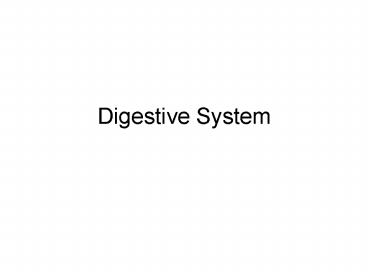Digestive System PowerPoint PPT Presentation
1 / 43
Title: Digestive System
1
Digestive System
2
(No Transcript)
3
Digestion
- Digestion is the physical and chemical breakdown
of food
4
Oral cavity Mouth
- Teeth
- Allow for taking in food and chewing
- 32 adult teeth
- 20 baby teeth
- Covered by enamel, the hardest substance in the
human body
5
(No Transcript)
6
(No Transcript)
7
Salivary glands
- Glands located in the head neck region
- Make saliva
- Moisten food
- Some chemical breakdown of food (especially
carbohydrates) - Antibacterial
8
(No Transcript)
9
Pharynx
- Throat
- Swallowing takes place here
- Eustachian tube (Auditory tube) connects pharynx
with middle ear
10
(No Transcript)
11
(No Transcript)
12
Esophagus
- Muscular tube that connects pharynx with stomach
- Functions to transport food via peristalsis
13
(No Transcript)
14
(No Transcript)
15
Stomach
- gastr- is stomach
- Located in your abdominal cavity, just under
ribcage on left side - Stores and mixes food
- Liquefies food
- Secretes HCl for protein breakdown
- Secretes mucus for protective lining
16
(No Transcript)
17
(No Transcript)
18
Small Intestine
- Small in diameter, not length
- It is over 20 feet long
- Has villi and microvilli
- Has numerous blood vessels
19
(No Transcript)
20
(No Transcript)
21
Small Intestine
- Absorption of food
- Peristalsis
22
(No Transcript)
23
Pancreas
- Important in digestion although food does not
pass through the pancreas - Releases juices into the beginning of the small
intestine that break down food enzymatically
24
(No Transcript)
25
Liver
- Although food does not pass through the liver, it
is important in digestion - Large organ that lies just below your rib cage on
the right side - hepat- means liver
26
(No Transcript)
27
Liver
- The liver makes bile to help break down fats into
smaller pieces thus making them easier to digest - The liver is the major site of detoxification
with its enormous blood supply - Liver stores nutrients (e.g. glucose, minerals,
vitamins - Central hub of metabolism
- Makes clotting proteins
28
Gall bladder
- A small pouch near the liver
- Stores bile
29
(No Transcript)
30
Large Intestine
- Named for the diameter, not the length
- It is about 5 feet long
31
Large Intestine
- Appendix small pouch at the beginning of the
large intestine no useful function - Colon most of the large intestine
- Rectum large intestine that enters the pelvic
cavity - Anus Sphincter muscles that is the terminal
opening of the large intestine
32
(No Transcript)
33
(No Transcript)
34
Large Intestine
- Forms and stores waste called feces
- Mucus secretion
- Minor water absorption
- Vitamin K and some B vitamins are made by
bacteria in the large intestine
35
Indigestion
- Abnormal digestion
- Heartburn acid spills upward into the esophagus
has nothing to do with the heart - Colic babies sometimes get digestive pain,
often due to difficult digestion of lactose
36
Gastroenteritis
- Vomiting Reverse peristalsis. Complications
from severe vomiting include dehydration, pH
changes in body, esophagus, throat, mouth
irritation - Diarrhea Increased peristalsis or increased
water content in feces. Prolonged diarrhea can
lead to dehydration
37
Food Poisoning
- Staphylococcus - Toxins released in high-protein,
moist and warm foods Acute - Salmonella - bacteria common in poultry and hogs.
Gastroenteritis signs. Cooking will kill the
organism - Campylobacter - Common in chicken. Killed with
proper cooking
38
Gastric ulcer
39
Appendicitis
40
Cirrhosis
- Scarring of the liver
- Permanent
- Most common cause is chronic alcohol use
41
Eating Disorders
- Anorexia nervosa
- Bulimia
42
(No Transcript)
43
(No Transcript)

